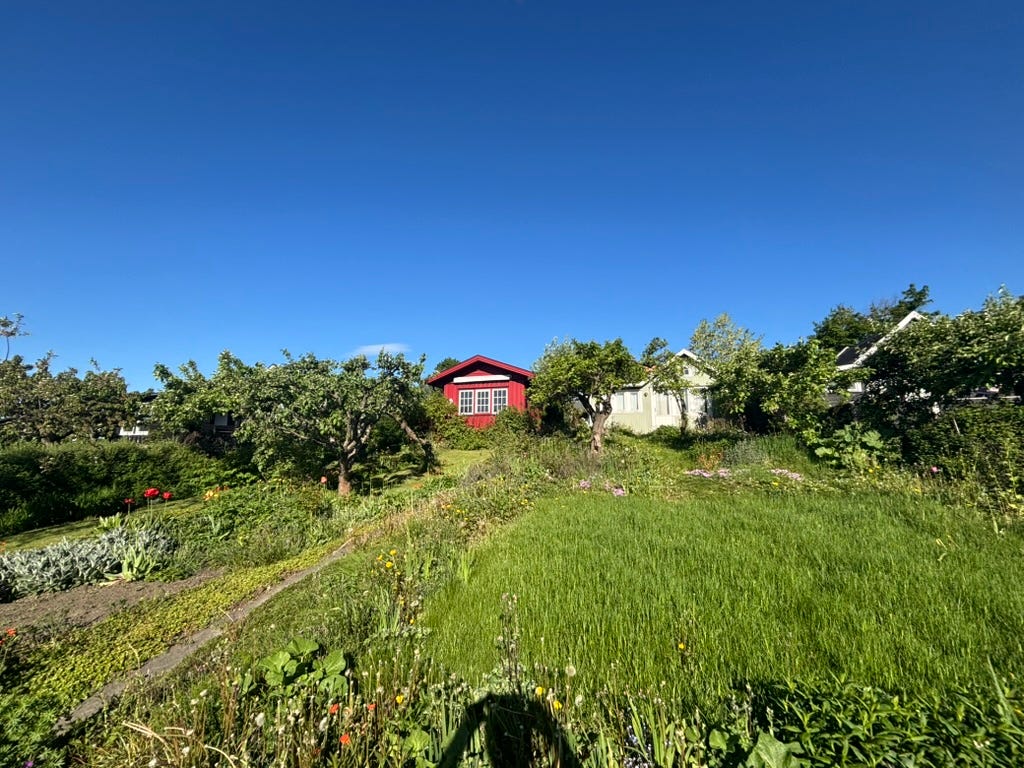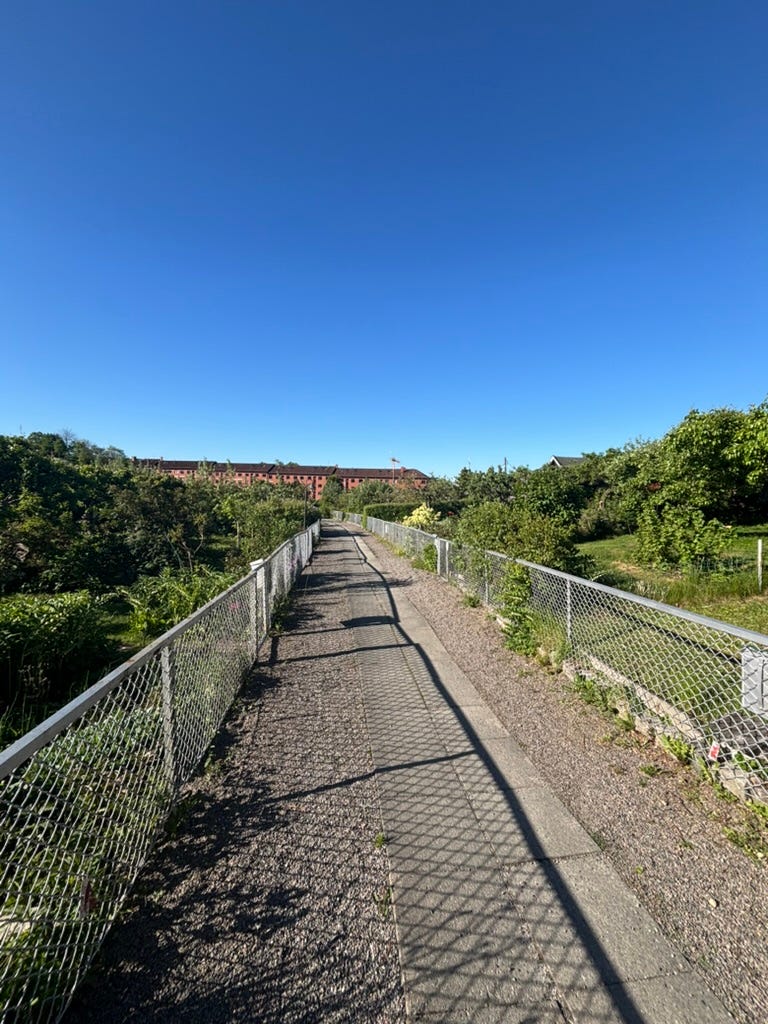When I was there in May, I realised that I had forgotten how far north Oslo was. The light at 6am caught me off guard. At 11pm, it was still bright, but I was used to it.
This persistent sunlight meant that even though it was a busy week, at both ends of the day there were nonetheless hours and hours to spend sitting in parks and cafes, listening to the sounds of Oslo — when there were in fact sounds. Mostly, Oslo is silent. Sometimes you are disturbed by a child’s laughter, but otherwise there are no sirens, no construction noises.
Late each day the sun became low-angled, following us around as we went to theatres and, via trains and rented bikes, up to the hills on the northern edge of the city where we could see the forest and the sea filled with islands. We were both in a ‘scenic-route’ kind of mood, which one particular evening meant that on the way to a bar in Grünerløkka we turned left off the street and through a gate onto a little path with gardens lying on both sides. I didn’t take much notice, until suddenly I did, and stopped and looked around at where I was.
When you’re in Oslo as a Londoner, you do not expect to be too surprised by anything. It’s a wealthy modern city filled with stereotypically quiet people, and so you think to yourself that you’ve seen it all before. But this was not something I had seen before. There were smallish lawns fringed with flowerbeds full of flowers which mostly I didn’t know. Here and there were some daffodils I suppose. Fences divided plots from their neighbours, and within each of them stood a cabin of uncanny proportions: too small to be a house, too big to be a shed. Mostly they were set far back from the public footpath so you couldn’t peer in and see exactly what was inside.
This probably does not sound very confusing, but it was, because I couldn’t work out what I was looking at. It wasn’t really an allotment, and neither was it a park. It was like a suburb, except not for living. It was like a holiday village in the centre of the city.
My fiancée said that we were in a kolonihage as it if were all perfectly natural. For a Norwegian, a large expanse of quasi-rural private gardens and holiday cottages sitting in the centre of the happening quarter of a wealthy capital city was no big deal. She carried on walking.
I spend a lot of time on Google Maps zooming into various places, and very often, without really intending to, I find myself zooming very close into the wild and desolate parts of Canada, Norway, and Russia. In the Arctic wilderness there is a lot of crystal-clear coverage where you can see distinct tussocks in bogs and puddles forming on glaciers. These three countries just mentioned could be cynically described as leftover land: Norway in particular spent a lot of time as the outer reaches of the Danish and Swedish kingdoms, whose administration was made difficult by the fjords and mountains and ice. With this history, it is perhaps unsurprising that a Norwegian would simply shrug at the idea of their land being used in such an obtuse, inefficient way. Obviously, the UK is not like this, with nothing like the same amount of wilderness and with a density of a different magnitude. Central London’s 10,000 people per square kilometre is nearly 10x that of Oslo. And so therefore London has a handful of very small allotments, and Oslo has its sprawling, decadent kolonihager.
‘Density is good’ is more or less the orthodoxy in contemporary urbanism, and has been for a long time. We need not rehearse the arguments about how walkability, terraced housing, and street-based life can redound to happier, safer, richer people. Contemporary YIMBY-ism is aimed at liberalising restrictive zoning policies and encouraging the proliferation of housing in existing neighbourhoods. There is also a political economy here too: by building densely in currently desirable neighbourhoods, you give more people access to the benefits of such places at the same time as exerting downward pressure on house prices and therefore the house prices of wealthy incumbents.
While all this is very convincing, pro-density urbanism sometimes misses that density is not a necessary condition for delight. It is possible to design low-density urban living which scores highly on whatever metrics you like to use, while at the same is beautiful and just. Maybe low density is not just parking lots in Houston and downtown Los Angeles, it is also kolonihager. The fact that within the centre of the Oslo there are green spaces with what are effectively second homes says a lot about the history and political economy of Norway, in the same way that the Royal Parks say a lot about the history of London.
However, the idea that Norway has infinite land and thus can just be profligate with its urban space is not really correct at all. Oslo has restrictive zoning policies on the fringes of the city where the forest and hills begin, and it has been experiencing high housing costs thanks to constrained supply. The space in Norway is vast, but it is forever ‘out there’, and not enough where it needs to be. Want a kolonihage? Get in line — behind 10,000 others, to be precise. The gardens are a benefit controlled by the municipal authority, and are given to those with the good fortune of having been on the waiting list for a long time, so is not that great for newcomers.

In such conditions, it appears odd to be using premium inner city space so inefficiently. There is dissonance between the way the city flaunts a theoretical surplus of space by giving a select few an extra home, while at the same time rents rise and the economy wobbles.
But stop! This is cost-benefit thinking! When it comes to cities, such thinking makes sense when it comes to trying to justify some state of affairs, but it really won’t get you very far in understanding why those states of affairs persist. The rationally-optimal land use is strictly irrelevant when it comes to the task of looking closely at the kolonihager and working out what they say about Norway and about Oslo.
The great novel of contemporary Norway, Knausgaard’s My Struggle, gets a lot of attention for its for the descriptions of each coffee and cigarette, every cup washed in the sink, every intrusive thought. Often this is overdone, and in fact reading the novel you are not made subject to a constant flow of undifferentiated experience, but instead you are given a strategic selection of passages which delineate the primary turning points of the author’s life, and since these are told with such precise attention to detail it means that the story of the author’s life becomes peculiarly less and less about the author himself and more about the objects and phenomena around him, the persistent yet shifting thingliness of the world. The result is that often the book reads like log of how the phenomena of regular Norwegian life have changed across a forty-year period, from Knausgaard’s childhood to the time of writing around 2008. Most importantly, that period spans near-perfectly the discovery of oil in in 1968 at the Ekofisk field all the way to the 2008 crash, at which point Norway is established as probably the most prosperous society in human history. Knausgaard never tells you that the cars change, nor the cleaning products or the music. He never tells you about the new highways, the expansion of Stavanger and Kristiansand, the oil fund, but because he looks at everything, it is all there, and as a reader you feel it at the peripheries of experience.
The obsessive noticing of My Struggle is the noticing of wealth as it accrues, and of the way the older way of leaves its residue. There are many other Norwegians who have, over the last half-century, done the same thing, those who remember life before oljefondet, whose parents fished for money and whose dialects were nothing like the urbanised, quasi-Danish bokmål. Norwegian national identity is in some ways premised upon the rustic existing within the modern’s particulars, and can be seen in all sorts of ways, like for example in the fact that around 50% of the country has some kind of ‘access’ to a cabin in the countryside, the sorts of huts often without electricity or running water. Parents let kids roam around in forests on their own, something unthinkable in the US or UK. While Norwegians are very proud of their advanced economy, their energy independence and their sovereign wealth fund which owns a bit of every company on the planet, at the same time they see themselves as most comfortable swatting mosquitoes in the forest or fishing from a boat.
The wealth is novel, which means there is a cultural imaginary about how Norwegians still have to be hardy and have the ability to live off the land, just in case. To some degree, this is only intensifying. Norway has recently moved from being a cashless society explicitly in order to prepare for a conflict with Russia in which payment systems might fail. Municipalities are reopening old bomb shelters and sending people handbooks about how to live without electricity. This resilience ideology sometimes has a collective emphasis, and it comes with homework. I was in Oslo around the 17th May, the Norwegian national day, and on the door to the building in which we were staying there was a poster pinned to the door advertising the dugnad — communal labour, cleaning, gardening, DIY — that everyone in the building was commanded to do in order to spruce the place up ready for the celebration.
One of the topics that resilience ideology influences is food production. You do not have to look too hard to find theories about how kolonihager are useful as educational resources for teaching populations about how to grow food which might become useful in a crisis. Such theories have their histories. During World War II, for example, Swedish allotments produced about 1/6th of the country’s potatoes. It is claimed that in the 2000s, more than half of Russia’s total vegetable produce came from micro-scale dacha gardens grown and exchanged informally.
If you actually were to run the cost-benefit analysis on this line of argument, it would be extremely difficult to defend the idea that these kolonihager are an insurance policy against economic collapse tail risks. For one thing, the scale is so small, there being only about 2,000 kolonihager plots in Norway, compared with the 61,000 allotments in Denmark. Often, the research resorts to advocating for second-order effects, in which social relations, integration, and entrepreneurship are seen to be promoted by the existence of urban gardens, instead of making any claims about what kind of food production may or may not indirectly result from them in certain future circumstances.
I guess Norway does still ‘live off the land’, if by that we mean drilling lots of oil out of it. As an artificial pastorality, a luxury image of rurality, the kolonihager are the appropriate symbol for such a country, and that is a compliment. A lot of urban life that we instinctively enjoy happens when cities seem to get away with something despite what is rational. Think of the self-organising street dining of Mexico City, the unreasonable peacefulness of some central Parisian streets, or the fact you can leave a bike unlocked in Tokyo. We can say that Oslo is getting away with its kolonihager.









